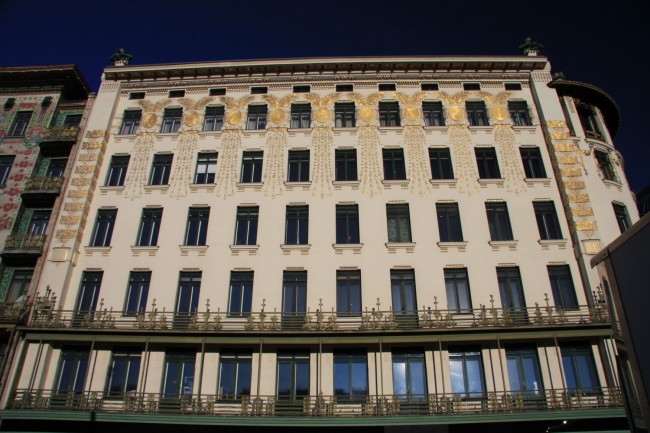I’ve visited Vienna four times and each time the experience gets better. A city rich in culture it is the venue for 1,500 classical music events a year. And what can I say about its over 100 museums, live theatres and opera houses other then fantastic. Significant art collections from historical to cutting edge contemporary, which few other cities can match, are all on display in Vienna.
The city’s public transport is amazing, the second last time I was there Vienna’s international airport was being modernized and expanded. A friend recently told me that the airport’s “Check-in-3” is now complete making your experience at a major airport enjoyable. This past winter my wife, son and I took the train from Budapest to Vienna only to find that Vienna’s already efficient train system will be improved further with the construction of a new Hauptbahnhof (main train station) by next year. The Karlplatz subway station, a favourite of mine since two members of the Viennese Succession art movement (which I adore) built it in the Jugendstil (art nouveau) style in 1899. Karlplatz is a major transfer point in Vienna’s subway system and is currently undergoing renovation to make it even more efficient.
Vienna is where coffee and cafe culture was introduced to Europe and where many of Europe’s great minds lived. The city was home to Sigmund Freud, Wolfgang Amadeus Mozart, Ludwig van Beethoven, Josef Haydn, Johann Strauss, Franz Schubert, Gustav Klimt, Egon Schiele, and many others who influenced the fields of medicine, science, music, architecture, the visual arts and many other fields of human endeavor.
I love classical music which makes Vienna a gold mine if you want to search out the apartments of composers who influenced music and hundreds of years later still have followers around the world. In Vienna you can find no less than eight residences that were home to Mozart, Beethoven, Strauss, Schubert, Brahms and Haydn.
Tucked away on Domgasse, a narrow street behind Stephansdom (St. Stephen’s Cathedral) the heart of the Austrian Empire, is the unassuming entrance to Mozarthaus (Mozart House) where Wolfgang lived from 1784 to 1787. This is his only surviving Viennese residence.

One of Beethoven’s three existing Viennese apartments on the right, with the University of Vienna in the background. Known as the Pasqualatihaus it is build on part of the city’s old fortification walls. In this apartment Beethoven composed his 4th, 5th, 7th and 8th symphonies.
Mozart’s apartment is well furnished with displays that provide in-depth insight into his life. A prestigious bel etage his two and a half years here were among his most productive, standing quietly you can imagine him sitting at the piano in front of you composing “Le Nozze di Figaro”.
Cutting edge art is what Vienna was all about. While today we see Beethoven and Mozart as being classical musicians in their day were ahead of their time. Vienna ebbed and flowed between historical art forms to being the leader of the artistic pack (today it generates a lot of revenue displaying its artistic past).
I love the art of Gustav Klimt who along with Josef Hoffmann, Max Kurzweil, Joseph Marie Olbrich, Koloman Moser and others founded the Viennese Secession (Art Nouveau or Jugendstil) in 1897. The Viennese Succession rejected Vienna’s then historic-based art scene. Their artistic vision incorporated painting, sculptor and architecture, taking a holistic approach to art. It inspired other renowned artists such as Jozef Mehoffer and Egon Schiele, another favourite of mine.
Klimt did not limit himself to painting but also created superb works of art in the form of objects d’art, murals and sketches, often focusing on the female form. A few of Klimt’s most famous paintings are The Kiss; Judith and the Head of Holofermes; and Adele Bloch-Bauer. The latter selling for over $100 million and it now hangs in my favourite Upper East Side Manhattan gallery the Neue Galerie. Klimt’s works are found in other famous Viennese museums including the Leopold Museum and the Belvedere Palace’s Austrian Gallery.

A display inside the Succession Building Art Museum (Secessionsgebäude) – Is this art or was the artist being a compete arsehole?
Angered by having his art rejected for display by conservative elements within the Viennese art establishment Klimt and Secession architect Joseph Maria Olbrich built the Secessionsgebäude (Succession Building), one of the most beautiful pieces of Jugendstil architecture that I’ve seen anywhere in the world. Klimt didn’t believe in the censorship of art and to this day the Succession Building displays cutting edge art. To reinforce Klimt’s support of artistic freedom and experimentation he had chiselled into the wall above the entrance of the Succession Building“Der Zeit ihre Kunst. Der Kunst ihre Freiheit.” (“To every age its art. To art its freedom.”).
Cafes and outdoor concerts during the summer with balls and operas during the winter the social scene in Vienna is vibrant year long. While in central Europe, Vienna has a Mediterranean feel to it. An elegant city it’s no wonder that it consistently ranks as one of the world’s top ten cities for quality of life.
Photo Credits
All photos by Joseph Frey – All Rights Reserved





It is a great city which only improves with time. Cheers,
Joe
An enjoyable reminder of my first (and so far only) trip to this magnificent city. Thanks Joe.